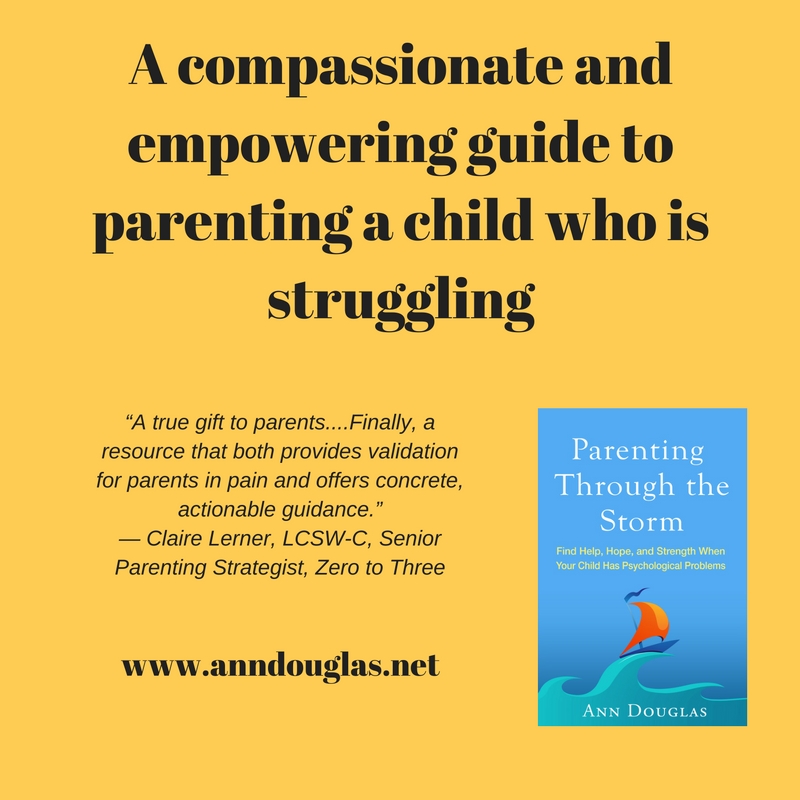The US and International edition of Parenting Through the Storm by Ann Douglas has just been published by Guilford Press.
Over the past year, I've heard from a lot of parents in countries outside of Canada, wondering how they could get their hands on a copy of my book Parenting Through the Storm.
One American parent who really wanted to read the book went so far as to have a Canadian friend purchase and mail her a copy of the Canadian edition. Now that's persistence and dedication!
Well, as of this week, parents outside of Canada will no longer have to resort to such extreme measures to get their hands on a copy of the book.
The US and International Edition of Parenting Through the Storm has just been published by Guilford Press, a respected publisher of books about mental health, education, and parenting.
About the book
This is easily the most personal book I’ve ever written.
I talk about my children’s struggles, my family’s struggles, and my own struggles.
But this book is so much more than a book about struggle.
It is also a book about hope and healing and resilience—about practical things you can to do to make life better for your child and your family, starting right now, even before you have a definitive diagnosis or treatment plan in place.
A lot of that wisdom is based on the best advice of the 60 other parents I interviewed for the book—parents who bravely opened up about their families’ struggles in an effort to make things better for other parents and kids. These parents offered practical advice on everything from making sense of a child’s diagnosis to dealing with bullying to advocating for a child at school. And they offered messages of encouragement and support, like the fact that having a child who is struggling doesn’t make you a bad parent, just as being a child who is struggling doesn’t make your child a bad kid. It’s just the particular challenge your family is dealing with.
What people are saying about the book
The book attracted some very positive pre-publication reviews and it has already been featured in a few media stories, too:
- Kinstantly talked to me about what it is like to be the parent of a child who is struggling (from the vantage point of a mom of four and parenting expert who has lived through it).
- Psychology Today blogger Susan Newman (who is also a parent, author, and psychologist) wrote about the book in a post entitled 12 Warning Signs That Your Child May Have a Mental Health Issue: How's Your Parent Radar?
- Images & Visions of Hope (IVOH) invited me to write this post about the writing process -- what it was like to write about my own family's experiences as well as the experiences of other families.
- Jennifer S. Smith of the Confident Parents, Confident Kids blog invited me to contribute this guest post about teaching kids about emotions.
- The TILT Parenting podcast interviewed me about stigma: how stigma makes it harder for parents to reach out for the help and support their families need.
- Bestselling parenting author Michele Borba interviewed me about my reasons for writing the book.
How the American edition is different from the Canadian edition (and vice versa)
I've had a few people ask me how the Canadian and American/International editions of the book are different, so I figured I should answer that question here, too. The Canadian edition of the book is, well, very Canadian. It talked a lot about the mental health and education systems in Canada, featured Canadian experts, spotlighted Canadian research and resources, and suggested some uniquely Canadian solutions to our uniquely Canadian challenges. (Hey, I told you it was very Canadian.) That book wouldn't have been particularly helpful for an American parent who was trying to make sense of American laws (think ADA, IDEA, and 504) or to figure out what supports were available to their family and their child -- and what supports should be available to their family and their child (the advocacy piece of the puzzle). That's why I had to research and rewrite large sections of the American and International edition of the book from scratch. I figure that about 75% of the content is the same for the two editions of the book and about 25% is different.
The good news is that I didn't have to tackle these far-reaching book revisions on my own.
As I noted in the acknowledgments for the book, it's impossible to write a book of this kind without the help of a great many people:
- the parents who trusted me with their families' stories in an effort to make things better for other families and
- the many experts I interviewed while conducting my research: Darcy Gruttadaro, director of the National Alliance on Mental Illness (NAMI) Child and Adolescent Action Center in Arlington, Virginia; Ellen Leibenluft, chief of the Section on Bipolar Spectrum Disorders at the Emotion and Development Branch of the National Institute of Mental Health; Liza Long, mental health advocate and author of The Price of Silence; Alison Malman, executive director and founder of the campus mental health advocacy group Active Minds, Inc.; Megan McClelland, Oregon State University developmental psychologist and coauthor of Stop, Think, Act: Integrating Self-Regulation in the Early Childhood Classroom; Marilyn Price-Mitchell, developmental psychologist and author of Tomorrow’s Change Makers: Reclaiming the Power of Citizenship for a New Generation; Andrew Solomon, mental health advocate and author of The Noonday Demon and Far from the Tree; Joshua Weller, assistant professor of psychology at Oregon State University; and last, but certainly not least, Nancy L. Wolf, mental health advocate and founder of Your Bridge Forward, whose input into the U.S. edition of this book was truly invaluable.
So there you have it -- the book publishing news from here!
If you know someone who would benefit from this book (perhaps the parent of a child who is struggling, a teacher who wants to learn how to better support parents and kids who are going through a difficult time, or a clinician who would like to have a book of this kind to recommend to parents), it would be great if you would tell them about it.
Any questions? Ask away! I'd love to hear from you.





